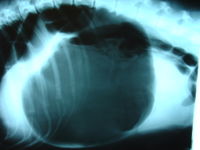
Photo from wikipedia
Though gastric volvulus in neonates and infants resolves by conservative therapy and aging, some cases require surgical intervention. This study aimed to review the cases of gastric volvulus requiring surgical… Click to show full abstract
Though gastric volvulus in neonates and infants resolves by conservative therapy and aging, some cases require surgical intervention. This study aimed to review the cases of gastric volvulus requiring surgical intervention and evaluate their characteristics. We retrospectively reviewed gastric volvulus cases requiring surgical intervention. Surgical indication was persistent acute gastric volvulus and repeated hospitalization for gastric volvulus. We evaluated the characteristics of those cases requiring surgical intervention and the surgical results of laparoscopic gastropexy. The median age of patients included was 4 years (range: 1–6 years). All eight cases of gastric volvulus requiring sugery had congenital spleen diseases. Six of the eight cases suffered from a wandering spleen, while two cases presented with situs inversus with asplenia. Both splenopexy (preperitoneal distension balloon [PDB] or blunt separaion methods) and gastropexy were performed in cases with wandering spleen. No postoperative complications were reported in any of the eight cases, except the recurrence of gastric volvulus due to suture shedding in one case. Laparoscopic gastropexy for gastric volvulus and splenopexy for cases concomitant with wandering spleen were found to be effective surgical approaches. Both PDB and blunt separation methods for making extraperitoneal pockets for the spleen were employed successfully.
Journal Title: Pediatric Surgery International
Year Published: 2022
Link to full text (if available)
Share on Social Media: Sign Up to like & get
recommendations!